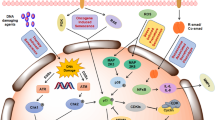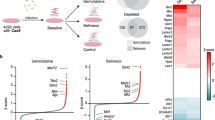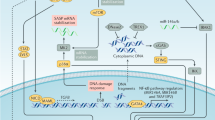Abstract
Oncogenic-stress-induced senescence (OIS) is a stress response allowing normal cells, when receiving oncogenic signals, to stably arrest their proliferation. OIS thus acts to prevent aberrant cell proliferation and tumor formation. To identify novel tumor suppressive pathways, we have recently completed a loss-of-function genetic screen to identify novel genes promoting escape from OIS and thus, potentially, tumor formation when their functions are lost. Using this approach, we unexpectedly found that loss of function of the multidrug resistance protein 3 (MRP3 or ABCC3) promotes escape from OIS in human epithelial cells. Importantly, ABCC3 expression is reduced in human skin tumors, and ABCC3-knockout mice display increased sensitivity to RAS-induced skin carcinogenesis, concomitantly with decreased OIS. ABCC3 participates in resistance to chemotherapy via its transporter activity. Our data show that this transporter activity is involved in ABCC3-induced senescence, demonstrating that this protein has a complex role in cancer, since its loss of function may promote escape from OIS and tumor formation whereas its gain of function promotes resistance to chemotherapy.
This is a preview of subscription content, access via your institution
Access options
Subscribe to this journal
Receive 50 print issues and online access
$259.00 per year
only $5.18 per issue
Buy this article
- Purchase on Springer Link
- Instant access to full article PDF
Prices may be subject to local taxes which are calculated during checkout




Similar content being viewed by others
References
Kang TW, Yevsa T, Woller N, Hoenicke L, Wuestefeld T, Dauch D et al. Senescence surveillance of pre-malignant hepatocytes limits liver cancer development. Nature 2011; 479: 547–551.
Collado M, Serrano M . Senescence in tumours: evidence from mice and humans. Nat Rev Cancer 2010; 10: 51–57.
Ben Porath I, Weinberg RA . When cells get stressed: an integrative view of cellular senescence. J Clin Invest 2004; 113: 8–13.
Hanahan D, Weinberg RA . Hallmarks of cancer: the next generation. Cell 2011; 144: 646–674.
Christoffersen NR, Shalgi R, Frankel LB, Leucci E, Lees M, Klausen M et al. p53-independent upregulation of miR-34a during oncogene-induced senescence represses MYC. Cell Death Differ 2010; 17: 236–245.
Ewald JA, Desotelle JA, Wilding G, Jarrard DF . Therapy-induced senescence in cancer. J Natl Cancer Inst 2010; 102: 1536–1546.
Humbert N, Navaratnam N, Augert A, Da Costa M, Martien S, Wang J et al. Regulation of ploidy and senescence by the AMPK-related kinase NUAK1. EMBO J 2010; 29: 376–386.
Lin HK, Chen Z, Wang G, Nardella C, Lee SW, Chan CH et al. Skp2 targeting suppresses tumorigenesis by Arf-p53-independent cellular senescence. Nature 2010; 464: 374–379.
Scurr LL, Pupo GM, Becker TM, Lai K, Schrama D, Haferkamp S et al. IGFBP7 is not required for B-RAF-induced melanocyte senescence. Cell 2010; 141: 717–727.
Cipriano R, Kan CE, Graham J, Danielpour D, Stampfer M, Jackson MW . TGF-beta signaling engages an ATM-CHK2-p53-independent RAS-induced senescence and prevents malignant transformation in human mammary epithelial cells. Proc Natl Acad Sci USA 2011; 108: 8668–8673.
Bianchi-Smiraglia A, Nikiforov MA . Controversial aspects of oncogene-induced senescence. Cell Cycle 2012; 11: 4147–4151.
Nelson DM, McBryan T, Jeyapalan JC, Sedivy JM, Adams PD . A comparison of oncogene-induced senescence and replicative senescence: implications for tumor suppression and aging. Age (Dordr) 2014; 36: 9637.
Zhang H, Pan KH, Cohen SN . Senescence-specific gene expression fingerprints reveal cell-type-dependent physical clustering of up-regulated chromosomal loci. Proc Natl Acad Sci USA 2003; 100: 3251–3256.
Lallet-Daher H, Wiel C, Gitenay D, Navaratnam N, Augert A, Le Cavé B et al. Potassium Channel KCNA1 Modulates Oncogene-Induced Senescence and Transformation. Cancer Res 2013; 73: 5253–5265.
Wiel C, Lallet-Daher H, Gitenay D, gras B, Le Calvé B, Augert A et al. Endoplasmic reticulum calcium release through ITPR2 channels leads to mitochondrial calcium accumulation and senescence. Nat Commun 2014; 5: 3792.
Gitenay D, Lallet-Daher H, Bernard D . Caspase-2 regulates oncogene-induced senescence. Oncotarget 2014; 5: 5845–5847.
Chen ZS, Tiwari AK . Multidrug resistance proteins (MRPs/ABCCs) in cancer chemotherapy and genetic diseases. FEBS J 2011; 278: 3226–3245.
Fletcher JI, Haber M, Henderson MJ, Norris MD . ABC transporters in cancer: more than just drug efflux pumps. Nat Rev Cancer 2010; 10: 147–156.
Kruh GD, Belinsky MG . The MRP family of drug efflux pumps. Oncogene 2003; 22: 7537–7552.
Kiyono T, Foster SA, Koop JI, McDougall JK, Galloway DA, Klingelhutz AJ . Both Rb/p16INK4a inactivation and telomerase activity are required to immortalize human epithelial cells. Nature 1998; 396: 84–88.
Gitenay D, Wiel C, Lallet-Daher H, Vindrieux D, Aubert S, Payen L et al. Glucose metabolism and hexosamine pathway regulate oncogene-induced senescence. Cell Death Dis 2014; 5: e1089.
Wiel C, Augert A, Vincent DF, Gitenay D, Vindrieux D, Le Calvé B et al. Lysyl oxidase activity regulates oncogenic stress response and tumorigenesis. Cell Death Dis 2013; 4: e855.
Acosta JC, O'Loghlen A, Banito A, Guijarro MV, Augert A, Raguz S et al. Chemokine signaling via the CXCR2 receptor reinforces senescence. Cell 2008; 133: 1006–1018.
Coppe JP, Patil CK, Rodier F, Sun Y, Munoz DP, Goldstein J et al. Senescence-associated secretory phenotypes reveal cell-nonautonomous functions of oncogenic RAS and the p53 tumor suppressor. PLoS Biol 2008; 6: 2853–2868.
Kool M, van der Linden M, de HM, Scheffer GL, de Vree JM, Smith AJ et al. MRP3, an organic anion transporter able to transport anti-cancer drugs. Proc Natl Acad Sci USA 1999; 96: 6914–6919.
Henderson MJ, Haber M, Porro A, Munoz MA, Iraci N, Xue C et al. ABCC multidrug transporters in childhood neuroblastoma: clinical and biological effects independent of cytotoxic drug efflux. J Natl Cancer Inst 2011; 103: 1236–1251.
Deeley RG, Westlake C, Cole SP . Transmembrane transport of endo- and xenobiotics by mammalian ATP-binding cassette multidrug resistance proteins. Physiol Rev 2006; 86: 849–899.
van de Wetering K, Feddema W, Helms JB, Brouwers JF, Borst P . Targeted metabolomics identifies glucuronides of dietary phytoestrogens as a major class of MRP3 substrates in vivo. Gastroenterology 2009; 137: 1725–1735.
Acosta JC, Banito A, Wuestefeld T, Georgilis A, Janich P, Morton JP et al. A complex secretory program orchestrated by the inflammasome controls paracrine senescence. Nat Cell Biol 2013; 15: 978–990.
Kuilman T, Peeper DS . Senescence-messaging secretome: SMS-ing cellular stress. Nat Rev Cancer 2009; 9: 81–94.
Abel EL, Angel JM, Kiguchi K, DiGiovanni J . Multi-stage chemical carcinogenesis in mouse skin: fundamentals and applications. Nat Protoc 2009; 4: 1350–1362.
Bizub D, Wood AW, Skalka AM . Mutagenesis of the Ha-ras oncogene in mouse skin tumors induced by polycyclic aromatic hydrocarbons. Proc Natl Acad Sci USA 1986; 83: 6048–6052.
Vindrieux D, Augert A, Girard CA, Gitenay D, Lallet-Daher H, Wiel C et al. PLA2R1 mediates tumor suppression by activating JAK2. Cancer Res 2013; 73: 6334–6345.
Zelcer N, van de Wetering K, de WR, Scheffer GL, Marschall HU, Wielinga PR et al. Mice lacking Mrp3 (Abcc3) have normal bile salt transport, but altered hepatic transport of endogenous glucuronides. J Hepatol 2006; 44: 768–775.
Acknowledgements
We thank Léa Payen for advice and Sarah Kabani for critical reading of the manuscript. This work was carried out with the support of the French National Cancer Institute (grants plbio 2010-181), the ‘Ligue contre le Cancer, comité de la Savoie’, the ‘Fondation ARC’, and the ‘RTRS Fondation Synergie Lyon Cancer’. CW is supported by the ‘Ligue Nationale contre le Cancer’ and the ‘Fondation pour la Recherche Médicale’.
Author information
Authors and Affiliations
Corresponding author
Ethics declarations
Competing interests
The authors declare no conflict of interest.
Additional information
Supplementary Information accompanies this paper on the Oncogene website
Supplementary information
Rights and permissions
About this article
Cite this article
Wiel, C., Gras, B., Vindrieux, D. et al. Multidrug resistance protein 3 loss promotes tumor formation by inducing senescence escape. Oncogene 35, 1596–1601 (2016). https://doi.org/10.1038/onc.2015.218
Received:
Revised:
Accepted:
Published:
Issue Date:
DOI: https://doi.org/10.1038/onc.2015.218
This article is cited by
-
Transcriptional repression of DNA repair genes is a hallmark and a cause of cellular senescence
Cell Death & Disease (2018)
-
Epithelial cell senescence: an adaptive response to pre-carcinogenic stresses?
Cellular and Molecular Life Sciences (2017)



